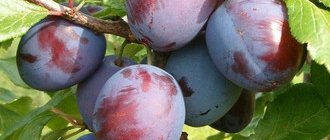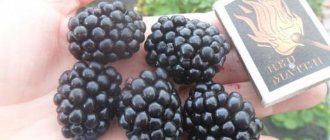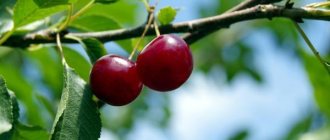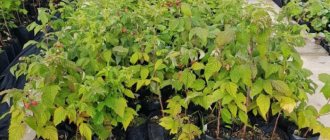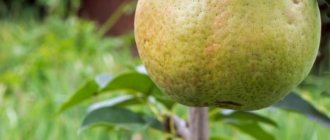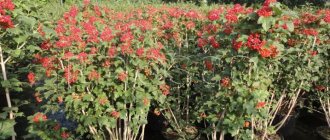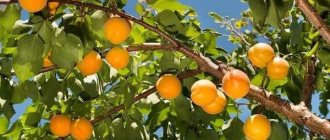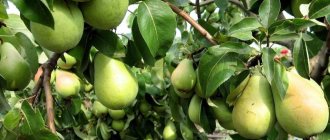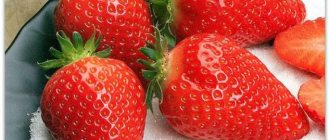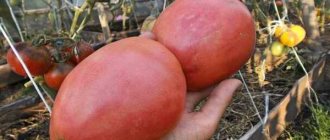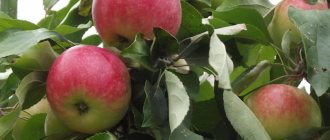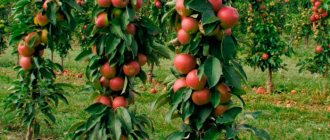Advantages and disadvantages of yellow plum
The advantages of yellow-fruited fruit varieties include the following characteristics:
- Productivity is above average annually.
- Immunity to most fruit tree diseases.
- Taste qualities of fruits.
- Most varieties survive frosty winters.
- Universal use in cooking.
The disadvantages of yellow plums include the thin skin of some varieties, which affects the keeping quality of the fruit. In addition, such hybrids are not suitable for most latitudes of Russia due to the fact that climatic conditions are not entirely suitable for growing trees.
How to choose a plum seedling?
The choice of planting material is always difficult, because one’s eyes simply run wild from the offers of nurseries, shops and private farms. Whatever variety you prefer, remember that the seedling must meet a number of requirements:
- dwarf or semi-dwarf rootstock;
- absence of dry twigs and rotten roots;
- height more than 140 cm, diameter from 1.3 cm (for the first grade), height more than 110 cm, diameter more than 1.1 cm (for the second grade);
- branched trunks with a height of at least 50 cm, a diameter of 1.4 cm, and a branch length of 20 cm.
In addition, the seedling will not show signs of disease, traces of lichen, broken or cut branches.
Characteristics of early ripening species
The description of the yellow-fruited plum is important to study due to the fact that there are several main varieties based on ripening time. Early plums ripen in early summer, but after harvesting they are not stored for long.
Yellow Ball
A characteristic feature of the Yellow Ball hybrid is the taste of the fruit. They resemble a mixture of peach and pineapple. The fruits are small. From a distance, the tree may resemble sea buckthorn. The variety is frost-resistant, able to withstand frosts down to -50 degrees. The tree bears fruit in the third year after planting the seedling.
Altai Yubileinaya
On average, the weight of the fruit is 15 g. The fruits are elongated-oval. Unlike other varieties, Altai Yubileinaya has a richer skin tone. The skin is covered with a waxy coating. Ripe fruits are fragrant.
Amber Mlievskaya
Large-fruited variety, fruits weigh up to 70 g on average. The fruits have a regular round shape. The taste of the pulp is sweet with a grape flavor. The skin is thin, so after harvesting the fruits are not stored for a long time. The yield is about 55 kg.
Honey
The Medovaya hybrid tastes like flower honey, which distinguishes it from other yellow-fruited varieties. It may be noted that the fruits have a slight sour taste. The fruits are large, weighing on average 30-50 g, round in shape. The skin is thin, but at the same time dense with a waxy coating.
Selection of seedlings
For ease of care and improved survival rate of seedlings, choose only high-quality, healthy planting material and buy it from a nursery. The tree is carefully inspected before purchasing. You should not choose seedlings with visible defects:
- with broken or damaged branches;
- with hail-damaged trunks;
- too dry plant with mold or rot;
- with suspicious spots and thickened areas on the roots;
- with a curved or crooked grafting site;
- with dying, drooping roots;
- with useless branches near the root collar;
- with a split stem.
Important!
The best survival rate is shown by seedlings aged 1-2 years.
The root system of a high-quality seedling is well branched and of normal color. In this case, the volume of the root system, consisting of 3-4 tap roots and many lateral roots, corresponds to the size of the above-ground part. The grafting site is 10 cm from the root collar and is entirely covered with bark.
Mid-season varieties
Mid-season plum varieties begin to ripen towards the end of summer.
Such hybrids have a longer shelf life compared to earlier varieties.
Ochakovskaya white
Ochakovskaya Belaya is characterized by low resistance to frost. At the same time, the trees are shade-tolerant. The yield is low, but the variety is quite popular among gardeners. After all, it is difficult to find a more delicious plum than Ochakovskaya Belaya. The fruits ripen in early September. On average, the weight of fruit is 40-55 g.
Kompotnaya
Compotnaya plum is suitable for growing in central Russia. Fruit weighing 30-45 g, regular oval shape. The plum is sweet and sour, juicy and aromatic, the skin is thin. Productivity is high and stable. Ripe fruits are suitable for fresh consumption and for preparing preparations for the winter.
"Golden Large"
Large and late plum, not afraid of frost. The buds bloom in May, but ripen in September. Begins to bear fruit after 4 years. Features good transportation.
The fruit weighs up to 45 grams, is yellow in color, with blush and a waxy coating. The abdominal suture is not visible. The small bone develops separately from the pulp, so it is easily separated. The fruit itself has a very delicate sweet and sour taste.
Late ripening
The advantage of late-ripening varieties is that after harvesting the fruits are stored for some time. But they are often inferior in taste to early and mid-early representatives.
Golden large
Large-fruited late hybrid, fruit weight is 40-50 g. The skin is pink-yellow, dense, slightly pubescent with a slight waxy coating. The first fruits ripen in early September. Large Golden plum is a partially self-fertile variety. The yield is average, up to 30 kg is collected from one tree. The golden large tree is winter-hardy; the tree tolerates frosts down to -35 degrees. In addition, the variety is resistant to drought and diseases.
Yellow Afaska
The fruits of the Yellow Afaska plum ripen in the second ten days of August. The fruits fully ripen in September. The tree is classified as medium-sized. The fruits are large, weighing from 45 g. The skin is dense, with a waxy coating. The stone is difficult to separate from the pulp.
The pulp is juicy and sweet to taste, with a sour aftertaste. The tree is winter-hardy and rarely suffers from fungal diseases.
Egg yellow
Egg yellow is considered one of the most ancient and rare varieties. This species is endowed with a large number of disadvantages and is grown mainly by collectors, and not by summer residents for harvest. The fruits are large and sour in taste. After harvesting, fruits are not stored for a long time. Plum is suitable for making compotes and marshmallows.
Svetlana
The advantage of the Svetlana variety is that there is no need to trim the crown every year. The hybrid is self-sterile; pollinator trees will have to be planted nearby. Fruit ripening continues until the last days of September. Fruiting begins in the 5th year after planting the seedling. On average, the weight of the fruit is 25 g. The seed is difficult to separate, the pulp is sugary with a sour taste.
Renklod Michurinsky
The maximum weight of Renklod Michurinsky plums is 35 g. The pulp is orange in color, juicy and sweet with a slight sourness. The bone is well separated from the pulp. The variety is productive, winter hardiness is high, fruiting is annual. The crown is medium dense, the tree is fast growing.
Khopty
The fruit is light yellow. There is a whitish coating of wax on the skin. Plums are small-fruited, weighing 15-20 g. There is a noticeable seam on the side of the skin. The skin is thinner than other varieties, the flesh is juicy, sweetish, and sometimes has a sour taste. The seed is large and is easy to separate from the pulp. Khopta plum is a self-sterile hybrid. Fruiting begins 2-3 years after planting the seedling.
See also
Description and characteristics of the Kabardinka plum variety, planting and careRead
Mountain
Mountain plum is a high-yielding variety that can withstand severe frosts. The crown is rounded, not thickened, the tree is medium-sized. The fruits are large, weight ranges from 28 to 47 g. The flesh is yellow, the shape of the plums is round. The pulp is sugary with a sour taste. The seed is difficult to separate from the pulp. The harvest ripens in the second ten days of August, the last fruits ripen in early September. The fruits are universal in use.
"Morning"
Grows of medium height with a dense crown. The leaves are light green, oval in shape. They are classified as self-fertile. It blooms in May and ripens in mid-August. Well preserved during transportation.
The plum is yellow-green with blush and white bloom. The weight reaches up to 30 grams, they have indentations at the base and an almost invisible seam on the surface. The taste is sweet, fibrous, and medium juicy.
Large-fruited
Large-fruited plum varieties are considered the most popular. Which is not surprising, because every summer resident, growing fruit trees on his plot, tries to achieve maximum yield. And the larger the fruit grows, the better.
Gigantic
The main trunk belongs to the tall category and grows within 4 m. The crown is abundantly dense. After planting, a young seedling bears fruit in the 3rd, sometimes 4th year. Productivity ranges from 36-41 kg. Plums weighing 40 g. The skin is dense, the flesh is sweet and juicy.
Angelina
The hybrid called Angelina belongs to the tall category. The trunk can grow up to 3 m. The fruits are oval-shaped and large. The weight ranges from 113 g. The skin is dense and glossy. The pulp is juicy, tastes sweet and sour. The seed is small in size and easily separated from the pulp. Angelina begins to bear fruit in the 2nd year after planting.
The president
Plum President is prone to rapid growth. Anti-aging pruning will have to be done twice a year. The fruits are large, weighing from 50 to 100 g. The skin is dense, with a waxy coating. The pulp is sweet and easily separates from the seed. The tree can withstand frosts down to -25 degrees.
Starting
Plum Startovaya is winter-hardy; there is no need to cover the tree for the winter. It tolerates heat calmly, although in case of prolonged drought, additional watering may be required. The plum tree begins to bear fruit early. Up to 55 kg of crop is harvested from one tree. Plum Startovaya has a long shelf life, it is 3 weeks.
"Egg Yellow"
A variety of late-ripening, not common variety. The tree grows tall with a sparse crown.
Large, oval, sometimes asymmetrical. This type of plum is perishable (up to 8 days). The surface is glossy light orange with dots. The stone is very difficult to separate from the sour pulp.
Self-fertile
Self-fertile varieties, compared to others, have a significant advantage. There is no need to plant a pollinator tree next to such a plant.
Golden ball
It is considered an early ripening variety. Belongs to the category of self-fertile. The first ripe fruits appear on the tree in July. The fruit has a sugary taste that is similar to peach. Weight ranges from 37 to 51 g. About 77 kg is collected from one tree.
Golden large
Large Golden plum is a winter-hardy and drought-resistant variety. In addition, plums are highly resistant to diseases. Productivity is late, the first fruiting begins in the 5th year after planting. Up to 27 kg of crop is harvested from one tree.
Covenant
The height of the tree is about 4 m; the plant bears fruit in the 4th year after planting. Flowering, like fruiting, is later. The weight of ripe plums is about 40 g. The shade of the skin turns from yellow to pinkish due to the sun. Ripening begins in the second half of August. Peel with a slight waxy coating.
Honey white
This variety is resistant to severe frosts. Fruit ripening occurs in late July - early August. The average fruit weight ranges from 40 to 55 g. 43 kg of harvest is harvested from one mature tree. When fully ripe, the peel takes on an orange tint.
Methods for growing plums
When growing this fruit crop, they usually use planting seedlings purchased from various stores and nurseries, but there are other methods. Plum propagates by seeds and vegetatively, but for simplicity, the second method is used.
Planting with seeds is used only to obtain seedlings for rootstocks. Seeds are removed from healthy fruits without signs of damage and soaked for 4 days, periodically changing the water. The seeds are then dried and stored in a closed container until planting. In the fall, they are mixed with wet sand and kept at temperatures from 0 to -10 degrees for six months. At the end of April, seeds are planted for germination.
Another way to grow plums is grafting. To carry it out, you need a rootstock seedling from a variety with high winter hardiness. For scion cuttings, shoots of existing trees are used or purchased specially. The grafting is carried out in the second half of spring or at the end of summer, when active sap flow occurs.
Good, strong seedlings are obtained from root shoots. To do this, in September, the root that has produced shoots is cut off from the mother plant. With the onset of spring, they are dug up along with the roots and transplanted to a new place.
Another method of independently obtaining seedlings is growing from root cuttings:
- To do this, dig up roots at a distance of 1-1.5 m from an adult tree.
- Roots 15 cm long and 10.5 cm thick are selected.
- Before planting, they are stored in the basement, placed in moistened sawdust with the addition of moss.
- In May, the roots are planted in deep boxes with a peat-sand mixture in a vertical or slightly inclined position, with the upper end buried 3 cm.
- The soil is mulched with sand and the box is covered with film.
- The boxes are placed in a dark place until shoots appear.
- During the summer, seedlings are fed with organic matter 2-3 times.
- After a year, the seedlings are transplanted into separate containers and grown to a height of 1.5 m.
- Then the young plants are transplanted to a permanent place.
What varieties of plums are best for the Moscow region and the middle zone?
Finding the best varieties of plums for the regions of the Moscow region and the middle zone is not as difficult as, for example, for the northern latitudes. Most varieties of the crop survive frosts in this climate.
Yakhontovaya
Yakhontovaya plum is a tall plant. The tree can reach 5-6 m in height. The crown is compact and wide. The fruits are round in shape, the peel is dense with a waxy coating. The pulp is juicy, the seed is easily separated. The weight of the fruit is 35-45 g. The taste of plums is sweet and sour. The tasting score is maximum and is 5 points out of 5.
Russian plum
Russian plum is an early ripening variety. The tree's yield is high and amounts to about 45 kg. The collected fruits, if they have not reached biological maturity, are capable of ripening. The fruits are large, weighing up to 55 g. The fruits are sweet and sour, the pulp is juicy. Skin with a white waxy coating. The disadvantage of the Russian plum is its rapid growth. After 2-3 years it is necessary to carry out anti-aging pruning.
Zlato Skifov
Zlato Skifov is not a variety of plum, but a type of cherry plum. But cherry plum is very similar in taste and appearance to plum, since it is a type of domestic crop. Zlato Skifov is a medium-sized plant, trees rarely grow more than 2 m. Flowering is abundant, the fruits are large, the weight is 40-55 g. A small seam can be seen on the skin. The skin is dense, covered with a white waxy coating.
Hungarian Bogatyrskaya
Hungarian Bogatyrskaya is a medium-sized, unthickened tree. Inflorescences are collected from 2-3 flowers. Ripe plums are ellipsoidal, weighing from 40 g. Maximum weight - 60 g. The skin is thick, with a thin waxy coating. The bone is small and practically cannot be separated from the pulp. The pulp is dense, greenish in color with a honey flavor.
Hungarian Bogatyrskaya is a frost-resistant variety. But it is difficult to tolerate prolonged drying of the soil.
Traveler
The fruits of the Traveler plum reach a weight of 20-35 g. The seam on the side is weakly pronounced. Skin with a waxy coating. The pulp is bright orange, soft, juicy. The skin is difficult to separate from the pulp. Traveler is a pollinating plum for some other varieties. The advantage of the variety is its resistance to severe frosts. Drought resistance is at an average level.
"Honey White"
Sweet variety of Ukrainian selection. Plum is not afraid of diseases and is a tall, heat-loving tree.
The taste is sweet with an aromatic note of honey and slight sourness. The stone is located close to the pulp, which makes it difficult to remove.
The plum is round, slightly oblong with a transparent skin. The fruit weighs about 50 grams and has a greenish to yellow color. Well preserved and withstands transportation.
Pollinators
Only self-sterile plum trees require pollinator trees. Such hybrids are selected according to flowering time. It is important that this period coincides with the flowering of the self-sterile variety. In addition, you can attract bees to the garden. To do this, the inflorescences are sprayed with water diluted with honey.
See also
Description and characteristics of Chinese plum varieties and features of choice for regionsRead
They bloom but do not bear fruit
Beginning gardeners are faced with the fact that the plum blossoms beautifully, but does not bear fruit.
Self-sterile plums cannot bear fruit without a pollinator. For such purposes, pollinating plums are planted. Each variety has its own pollinator, but if for some reason you do not know the pollinator of your variety, you should follow some rules when choosing:
- tree with annual flowering;
- the life expectancy with the main variety is the same;
- There is plenty of benign pollen.
Among the self-fertile varieties, the following varieties are distinguished:
- Early blue.
- Memory of Timiryazev.
- Common Hungarian.
- Spark.
- Red early ripening.
- Hungarian homemade.
- Hungarian Moscow.
Trees are planted within 60 meters.
Other reasons:
- The ovaries are destroyed by pests.
- Insufficient fertilizing in autumn. Fertilizers during this period are responsible for future fruiting.
- The trees did not have enough moisture.
- The region does not correspond to this variety.
- Soil with high acidity. Does not like trees or swampy places.
- Incorrect agricultural technology when planting. When planting, the root collar is buried and the tree becomes sick. The tree spends all its energy on restoration and fruiting does not occur.
- Plum age.
Disembarkation rules
All varieties of plums are planted according to the same principle. The process is not much different from other fruit trees:
- A few weeks before planting the seedlings, they begin to prepare the soil.
- Dig a hole, mix the top layer of soil with manure, wood ash and mineral fertilizers.
- The top layer of soil with fertilizers is poured to the bottom.
- After 3 weeks, they begin to plant the seedling.
- The tree is placed in a hole, the roots are carefully straightened and covered with soil.
- The earth is compacted near the trunk.
At the end of planting, the soil is watered generously with warm water. If necessary, drive a stake into the center of the hole and tie a seedling to it .
Deadlines
The optimal time for planting plum seedlings is September-October. You can plant a plum in the spring, but then it will begin to bloom in the year of planting, which will not have a very good effect on the yield. The advantage of the autumn procedure is that over the winter the seedling will have time to take root, and in the spring it will begin to actively grow with renewed vigor. It is not at all advisable to plant plums in summer.
Selecting a location and preparing the soil for planting
Plums prefer to grow in open sunny areas. Seedlings can also be planted in partial shade. The main thing is that the plant is in the shade for less of the day. Plums are not picky about soil. Light and fertile soils are suitable for normal seedling growth.
Planting scheme
The distance between neighboring trees should be at least 3 m. Especially if the plum is tall or has a spreading crown.
Rules for planting in a pit
After purchasing a seedling, you should not delay replanting. In most regions, planting in a previously prepared hole is practiced. The scheme is not difficult:
- It is necessary to dig a shallow hole no more than 0.7 m in diameter. It is better to replace part of the soil with a nutrient mixture based on black soil, turf, sawdust, and wood ash.
- Thoroughly loosen the bottom of the hole to stimulate root growth.
- Make a drainage layer from expanded clay, pieces of sea pebbles or clay bricks. In a wetland it should reach 10–20 cm.
- Fill the dug hole with nutrient soil 50–60%.
- Carefully place the seedling, straighten the thin roots with your hands, trying not to break the fragile shoots.
- Sprinkle the plum with soil up to the root collar and compact it loosely with your palms.
- Form a hole around the trunk for watering with water and nutrients.
- For an annual seedling, you need a support in the form of a wooden peg 0.5–0.8 m high.
After transplanting, the plum should be watered with water at room temperature. The liquid is poured in small portions throughout the day so that it is completely absorbed by the root system.
Important!
The “in a hole” planting method allows you to assess the condition of the soil, the level of looseness, and swampiness.
Agricultural technology and care
Thanks to constant tree care, you can achieve maximum yield. An annual seedling must be cared for regularly so that it grows healthy and subsequently bears many fruits.
Watering
Plums are not watered often. Some varieties that do not tolerate prolonged drought require additional moisture. In most cases, plums require 4 irrigations per season:
- The first watering is carried out in the first half of the season, when bud formation begins.
- The second time the plants are moistened during flowering.
- The third watering is carried out during the formation of ovaries and fruits.
- The last time the trees are irrigated is in the fall before the cold weather begins. This will prepare the plum for winter.
Plants should be watered only with warm water. One tree requires 5-8 liters of water. The amount of irrigation should be increased in the spring for seedlings. They can be watered every week. For one seedling, 3 liters of water is enough.
Top dressing
Feeding, like watering, is applied 4 times per season. In the first half of the season, plums need nitrogen. Nitrogen-containing fertilizers accelerate growth. Ammonium nitrate and complex fertilizers containing nitrogen are added to the soil. You can also use wood ash. In summer, trees need phosphorus and potassium. Superphosphate, bone meal, and ammophos are added to the soil. Nitrophoska is suitable for potash fertilizers. In autumn, manure and wood ash are added to the soil.
Mulching
Mulch the soil mainly in the fall. This measure allows you to protect the root system of the tree from frost. In addition, if you add mulch, the soil will be constantly saturated with nutrients and always moist.
Peat, manure, sawdust or straw are used as mulch. The layer should be at least 15 cm. Before mulching, the soil near the trunk is dug up and all weeds are removed. It is important to make sure that there are no weed roots left in the soil. Otherwise, after some time the weeds will appear on the site again.
Trimming
Not all plum varieties need pruning. Low-growing and not thickened hybrids can be pruned every 3 years. Vigorous plums require annual pruning. It is necessary to remove all young shoots and some branches. Leave 3-4 skeletal branches, cut off all the rest. In addition, the top is also removed. In the fall, sanitary pruning is carried out. Use sharp pruning shears to cut off dry and damaged branches. The cut sites are treated with a solution of potassium permanganate or iodine solution. However, it is advisable to process in all cases where branches have to be deleted.
Preparing for winter
Most plum varieties do not require significant preparation for winter. Many trees are quite capable of surviving severe frosts. The only thing you need to do is prune the plum before the onset of cold weather. Then it is advisable to dig up the soil and mulch the soil near the trunk.
In addition, the lower part of the trunk should be covered with dense material to prevent mice and other rodents from gnawing on the bark.
It is advisable to cover newly planted seedlings for the winter (even if this happened in the spring). Young plum trees are covered with spruce branches or wormwood.
Prevention and treatment measures
If you do not deal with plums, even hybrids with high immunity can contract diseases. Common drain problems include:
- scab;
- powdery mildew;
- rust;
- root cancer;
- moniliosis;
- fruit rot.
Plum treatment involves treating trees with biological products, fungicides and folk remedies. Preventive methods include spraying plants with Bordeaux mixture in the spring and timely pruning of dry branches. Every autumn you need to burn fallen leaves. In addition, to prevent the appearance of insects after harvesting in the fall, the soil around the plant is dug up to a depth of 15-20 cm.
Harvest and storage
The fruits are harvested at varying degrees of ripeness depending on their purpose:
- for fresh consumption, making juice or jam, drying and freezing, you must wait until full ripeness;
- For compotes or ripening, the crop can be harvested at the stage of technical ripeness.
When removing fruits, it is important not to damage the waxy layer on the skin; such plums will be stored longer. You should also leave the stalk, which will provide additional moisture during storage. After removal, the plums are laid in 3-4 layers, covered with paper. The optimal humidity level in the cellar is 80–90%, and when storing in the refrigerator, a temperature of about +5°C is required.
Yellow plums can be grown in any region if you choose the right variety and follow the basic requirements for planting and caring for the tree. Tasty and beautiful fruits are good for health and can be consumed both fresh and processed.
What problems can you encounter when growing
The main problem is the close planting of seedlings. Also, many gardeners ignore fertilizing and watering. It seems to them that since the plum bears fruit, then everything is fine. But if you do not take care of the plant, very soon the yield will begin to decline. Another problem is improper fit. It is not advisable to plant plum trees only where there is free space. It is important to choose a place where the plant will feel comfortable. You cannot plant plums in the shade.
Plum, like all stone fruits, tends to grow. Many gardeners prefer not to cut down young growth. And it is necessary to do this. After all, it takes all the nutrients, and the parent plant has nothing left.
Site selection
For successful cultivation, it is important to know how and where to plant plums in the spring, and to select a suitable site taking into account the biological characteristics of the plant. This fruit crop does not tolerate cold northern or eastern winds. Therefore, a site is selected that is protected from drafts on a gentle slope.
Plum prefers good lighting. To do this, choose an open place away from tall trees, houses and outbuildings. Constant exposure to the shade causes the trunk to bend and reduces the number of fruits. The root system of this plant is superficial. Therefore, groundwater must be deep in the area. A place in a lowland with a large accumulation of snow and melt water is not suitable for plums.
It is good when the plum falls into partial shade for a short time. Sometimes in summer, in particularly hot weather, the sun's rays burn the crown and trunk especially strongly. Then a light shadow becomes a real salvation.
Soil selection
It is best to plant plums in the spring in areas with soil consisting of loess-like loam and sandy loam. The second layer should be drained loam or layered sediments with a high sandy loam content.
Important!
This tree should not be planted in swampy and peat areas. Areas with high sand or clay-sand moraine are not suitable for cultivating plums.
Plum prefers fertile, loose soil with a neutral pH of 5.5-6. If the acidity in the area is too high, the quality of the soil is improved by adding dolomite flour or lime every 4 years.
Soil preparation
The soil for planting fruit crops is prepared in advance, 2 or 3 years in advance. Planting plums in the spring is done only after careful digging of the garden. This procedure saturates the earth with oxygen. If the soil on the site contains substances of little use, additional mineral complexes and organic matter are added to improve the fertile qualities.
For each square meter of soil add:
- 10 kg of humus or compost;
- 50 g superphosphate;
- 30 g of potassium nitrate.
You cannot plant plum seedlings immediately after uprooting other fruit trees from the site. In such soil there are too few useful substances left for the qualitative development of the crop. Therefore, the land is allowed to rest for 3-4 years.
How to mulch a plum tree?
Mulching around the plum tree trunk will help improve the wintering of plants and reduce soil drying out. If after planting you covered it with peat, then after 2 years you can repeat the process, or surround the roots of the tree with bark (chips) within a radius of 1 m.
- What mulch to use for different crops
The productivity and beauty of flowering plants often depend on what they are mulched with.
Mulch made from freshly cut grass or straw will also work, although the roots of the tree will have to be protected from rodents in the winter.
How to care after planting
Since the seedling adapts throughout the season, it is necessary to provide it with ideal conditions for development. It is important to follow a few simple recommendations; they will not take much time, but will be of great benefit and will help you grow a healthy plant that will survive the winter. Remember the following:
- Water only if the weather is dry and there is not enough moisture in the soil. Carry out the work once every 2 weeks, pour out 2-3 buckets of water at a time, let it sit for half a day so that it warms up to air temperature. It is best to do this in the afternoon after sunset, the water will be absorbed and absorbed by the roots faster.
- Mulch the surface after each watering. This will prevent the appearance of a hard crust on the soil, and if you use peat, it will serve as an additional fertilizer. You can also use available materials: mown grass, dried weeds, straw, sawdust. Leave space near the root collar so that it does not rot.
- If mulch is not used, then it is necessary to loosen the tree trunk once every 2 weeks, as well as after rains and waterings. Do not go deeper than 3 cm, do not damage the upper suction roots.
- There is no need to feed the plum in the first 2-3 years, since the prepared mixture has enough nutrients.
- In the fall it is necessary to prune. To do this, select the formation option in advance and remove all unnecessary shoots according to the scheme. If the tree is growing normally, then simply shorten the branches by about a third of the length. Use pruning shears, cut accurately and evenly, and carry out the work at least a month before the onset of cold weather.
- If planted in Siberia or the Urals, then in the first winter it is advisable to protect the plant from the cold. To do this, build a wooden frame, place it and fill it with pine branches or dry leaves.
The pegs to which the tree is tied must be removed after 1-2 months, when the plum takes root and begins to grow. In summer, if the weather is very hot, you can shade the plant with agro-canvas, this will easily retain moisture and prevent burns.
Landing instructions
It is very important to plant a plum tree correctly; the tree will quickly take root and begin to grow and develop intensively. Prepare a shovel and a container of water, which must first be settled if it is from the water supply. Follow these steps:
- Make a hole slightly larger in diameter than the root part of the seedling. If you purchased the version with bare roots, it is better to put it in water for a couple of hours, and then dip it in a mash of clay and humus. Make the depth so that the root collar is above the surface.
- Place the seedling in the hole, spread the roots around the perimeter, they should not bend or rest against the walls. Place a level strip on the ground, check the location of the root collar; it should be slightly higher than the surface, since over time the tree will inevitably shrink a little.
- Fill in a layer of earth approximately 15 cm thick. Level it, cover all the roots, and then pour out 30 liters of water, the soil will settle, fill all the voids, and the liquid will wet the bottom of the hole, and the roots will grow correctly.
- Install the support, and for the first time ensure the vertical position of the seedling. You can drive two pegs.
- Fill the soil to the top, make a slight elevation. Make a furrow around the perimeter so that the water will not spread during watering and precipitation.
- Tie up the trunk. Use soft twine, do not tighten it too much, do not crush the wood or damage the bark. Mulch the surface of the ground with peat to retain moisture.
It is best to carry out work in the morning or evening, when there is no sun. If bright sun is forecast, shade the seedling for 2-3 days to prevent it from getting burned. Compact the soil well, if after a few days it sag, add more.
Choosing a landing site
The correct placement of seedlings on the site is carried out taking into account the characteristics of the crop and variety, as well as the climatic characteristics of the region.
Select a landing site:
- sunny, not shaded by other trees or buildings - lack of light negatively affects the growth, development and fruiting of plums;
- protected from the winds – buildings and structures (from the north and east) can act as protection from cold winds;
- without the likelihood of spring flooding - even short-term stagnation of melt water will lead to sad consequences for the tree (refusal to bear fruit, weakened growth, freezing in winter);
- the distance from the fence, buildings and structures to the plum tree must be at least 3 meters to ensure uniform crown growth, ventilation, and accessibility of care;
- you can use a gentle slope (preferably southern) for planting for protection from northern winds and better insolation;
- plum trees should not be planted in lowlands or on marshy soils - this will lead to the death of the tree;
- The minimum permissible depth of groundwater is 2 meters, since the root system of the plum tree is superficial.
The more carefully the place for planting plums is selected, the fewer problems there will be in care and the higher the yield will be.
What crops can coexist with plums?
When planting a plum, it is important to take into account the peculiarities of its interaction with other crops. It is not recommended to plant it close to crops with similar surface roots. This will increase species competition and lead to the displacement of one of the crops - it will develop more slowly, yields will decrease, and susceptibility to diseases will increase.
Among the competing plants:
- sweet cherries and sour cherries are closely related stone fruit crops with a similar root system;
- raspberries - due to the characteristics of the root system, they will deprive the plum seedling of most of the nutrients;
- sea buckthorn is an aggressive neighbor, a competitor to plums, but will quickly lose the battle for the sun;
- currants - compete with plums for nutrients, fungal diseases spread quickly in such a neighborhood;
- pear - has a powerful crown, will quickly drive the plum into the shade;
- peach - cannot stand any proximity to other cultures because of its capriciousness;
- birch – has a powerful suction ability of the root system;
- Walnut is a natural herbicide that contributes to the death of other plants nearby.
Most berry bushes are bad neighbors for plum trees. The close proximity of these crops leads to the spread of pests and fungal infections. It is better to plant seedlings at a distance of at least 5-7 meters from them.
Culture does well with:
- honeysuckle - the shrub grows successfully in the shade of a tree already at a distance of 2 meters;
- other plum varieties - this planting is recommended for good cross-pollination;
- apple tree - such a neighborhood does not interfere with any of the crops;
- some ornamental trees have a beneficial effect on the plum tree, increasing its yield or saving it from insect pests. Among them are maple and black elderberry.
The compatibility of crops does not mean that they can be planted back to back; it is important to plant them at a certain distance from each other.
